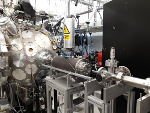| 11 | | 2. ** Update on feedback/questions from UKRI IAC on ITRF proposal: MN** |
| | 11 | 2. ** Update on feedback/questions from UKRI IAC on ITRF proposal: MN** \\ |
| | 12 | Since it was his first attendance at a LhARA SG meeting M. Noro introduced himself as a business-development lead at the STFC Daresbury Laboratory. In this role MN led the preparation of the ITRF proposal to the UKRI IAC in close cooperation with J. Clarke and others. The proposal-development team worked to find synergies with and to get support from the LhARA collaboration during the preparation of the proposal. An ITRF Advisory Committee has been established the membership of which has significant overlap with the membership of the LhARA SG. \\ \\ |
| | 13 | The ITRF proposal to the IAC was submitted on the 15Jun21. The principle deliverable was a "blue print" (CDR) of the ITRF. Early in September 2021 the IAC asked two questions: |
| | 14 | * Clarification of comparable proposals in other countries; and |
| | 15 | * What challenges must be addressed, and over what time line, to take the technologies demonstrated in the ITRF to the clinic. |
| | 16 | Answers had to be delivered in 100 words (each) and over a very short timeline and were prepared by the proposal team in consultation with the Advisory Committee. Later in September there was the possibility to submit additional information. The BJR paper referred to in the proposal was submitted along with letters of support from the project partners. There is still an opportunity to submit a letter of support from CERN. **KL** will re-engage with CERN to try and get such a letter before the IAC meeting (05Oct21). |
| 13 | | 3. ** Update on LhARA proposal preparation: CW** |
| | 18 | The next step in the process is the meeting of the IAC which will take place on 05Oct21. MN and JC have made themselves available to answer the committee's questions on that day. MN anticipates that the IAC will make its recommends to UKRI Council on the timescale of late October, early November. He expects feedback to the proponents on this timescale. |
| | 19 | |
| | 20 | SG asked whether biologist input would be valuable and whether AG and JP would be valuable if they could be available. MN replied it would be excellent if additional colleagues could be available but that he was not wishing to ask people to be available since they may not be required. KL felt the making robust and timely responses to the IAC's questions was of sufficient importance to the LhARA programme that LhARA collaborators would be willing to make themselves available. JP agreed, and said he was available. AG had left the meeting, so did not confirm. In view of the importance to the LhARA programme, **KL** agreed to liaise and supply MN with a contact list for the key aspects of LhARA. |
| | 21 | |
| | 22 | 3. ** Update on LhARA proposal preparation: CW** \\ |
| | 23 | See [raw-attachment:02-2021-09-27-Whyte.pdf slides]. Points noted: |
| | 24 | * KL: the financial information presented in CW's slides should be treated as confidential. The sensitivity was not that the numbers are secret but that we need to make them public when we are confident. Operationally we should think about this as being after the "internal review" by independent experts that is being discussed. In addition, while we had chosen to present a project-based integrated proposal, the resources to support the work did not have to come from only one source. |
| | 25 | * TP: the vertical beam line would be a great tool for LhARA but should not be considered to be essential. There are existing horizontal beam lines that could be used. |
| | 26 | * TP: commented that in developing the costing, the evaluation of years 3 to 5 was more difficult to work out as it relied on the results of the programme carried out in years 1 and 2. Consultation will begin as to how to deal with the uncertainties in the programme over years 3 to 5. CW agreed that the problem was difficult but the imperative remained to know how the instrumentation would be done by the end of year 5. |
